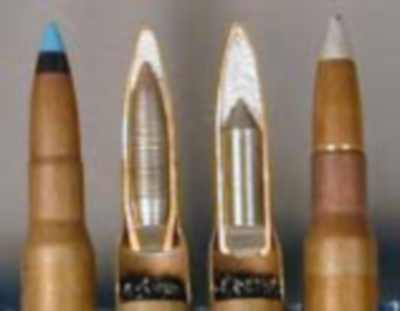 For a while now, ammunition has been in short supply, and many retailers have imposed limits on how much ammo a customer can buy. At Walmart, for instance, it’s three boxes per day. At Hot Shot Sports in Shnecksville, Pa., it’s five boxes per day. The store’s owner, Walt Schneck, says the store is out of 9 mm ammunition.
For a while now, ammunition has been in short supply, and many retailers have imposed limits on how much ammo a customer can buy. At Walmart, for instance, it’s three boxes per day. At Hot Shot Sports in Shnecksville, Pa., it’s five boxes per day. The store’s owner, Walt Schneck, says the store is out of 9 mm ammunition.
“Demand right now is over the top,” he says, adding that it has been that way since the shooting at Sandy Hook Elementary School in Newtown, Conn. “People got panicky,” Schneck says. “ They are coming out, buying guns and they’re buying ammo, and everything is just going off the shelf.”
In the U.S., ammunition is a $2 billion industry. “All of the manufacturers are operating 24 hours a day, seven days a week, to try to produce as much as they can to meet this unprecedented consumer demand,” says Lawrence Keane with the National Shooting Sports Foundation, the firearms industry’s trade association. Last month, Remington announced it is expanding its ammunition factory in Arkansas.
Still, manufacturers haven’t been able to keep up, and Walt Schneck says many of his customers at Hot Shot Sports have started to make their own ammo. They do it from scratch or they re-load casings from ammo they’ve shot. “As long as you can get the bullet, the powder, and the primer, and you have the casings, you’re good to go,” Schneck says.
According to C. Rodney James, the author of “The ABCs of Reloading,” there are other benefits. For one thing, it’s more precise, he says. You can tailor a round to an individual firearm. For another? “You can reduce the cost of your ammunition by about 60 percent if you basically assemble it yourself at home,” James says.
To do that, James says you need a press, dies and manuals to figure out how much powder to use. “You can put together a pretty good reloading outfit for a few hundred dollars — $250, $300,” he says.
Tim Miller, of Allentown, Pa., is one of Walt Schneck’s customers. He is a competitive shooter and a firearms instructor with STSK, who makes his own ammo. Miller teaches an eight-hour, $250 class on how to do it. “This is all the stuff I picked up from when I shot,” he says, pointing to brass cases. “It needs to be cleaned first, because if you don’t clean it, it’ll clog up your dies, and can actually dent the cases.”
Today, Miller is making .38 specials for a revolver. He resizes the cartridge and puts in a new primer. That is what will ignite the gunpowder, which he puts in next. Then, he seats a projectile –the bullet. It is a precise process. In a matter of minutes, Miller cranks out round after round. He estimates he can make about 300 in one hour.
At Hot Shot Sports, Miller would have to pay almost $250 for 500 rounds of factory-made .38 specials. He says he could make 500 rounds himself for $77. At the store, he does the math: “So, you’re about $7 for the powder, about $50 for the bullets, and about $20 for the primers, and that’s 500,” he says. ” So there’s a drastic difference.”
But it isn’t as easy to get those components as it used to be. “As there has been a run on guns and ammunition, there’s also been a similar run, although on a smaller scale, on reloading equipment and components,” C. Rodney James says. That includes the bullets — the projectiles that go into ammunition. So, some people also make those themselves.
Jim Finnerty is one of them. He lives in Groton, Mass. “You can really save a fortune by making your own bullets, as well,” Finnerty says. “Because after the brass case, which you get to reuse, the bullet or projectile is the second-most expensive component of the cartridge.”
Finnerty says he got into making bullets and ammo for economic reasons. Then, it became a hobby. “I mean, if I had taken up golf, I’d be at the driving range practicing every day, and if there was a shortage of golf balls, and there was a way to make my own, I’d probably do it.”
These days, more and more gun owners say it is becoming a necessity.
SOURCE : www.marketplace.org


